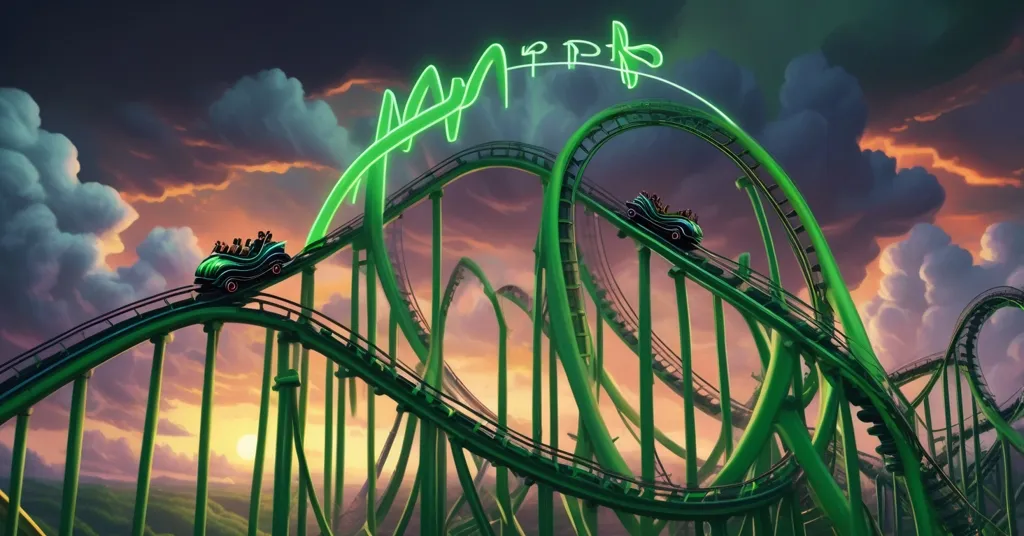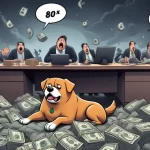XRP Volatility: Analyst Predicts $1 Crash by 2026 Despite 34% Rally

XRP’s Wild Ride: Expert Warns of Drop to $1 by 2026 Amid Rally and Risks
XRP, the fourth-largest cryptocurrency by market cap, is riding a wave of volatility that’s got investors on edge. With a 34% rally over the past year and a recent bounce to over $2, it’s outperformed many peers. Yet, one analyst is sounding the alarm, predicting a brutal slide to just $1 by 2026. Buckle up—let’s unpack the hype, the headwinds, and what this means for the future of this controversial altcoin.
- Impressive Gains: XRP surged 34% in a year, recovering to $2.19 after a flash crash, outpacing Bitcoin’s 14% retracement.
- Bearish Forecast: Analyst Sean Williams sees XRP tumbling to $1 by 2026 due to fading catalysts and fierce competition.
- Major Hurdles: Slow adoption, rivals like Solana and Stellar, and stock market correlations threaten XRP’s momentum.
XRP 101: A Quick History of Highs and Lows
For the uninitiated, XRP is the native token of the Ripple network, launched in 2012 by Ripple Labs with the goal of revolutionizing cross-border payments. Think of XRP as a middleman token—a bridge currency—that helps convert one currency to another during international transfers, slashing fees and delays compared to traditional banking systems. Its backbone, RippleNet, is a payment protocol used by financial institutions to move money faster than the clunky old methods.
XRP hit its all-time high of $3.84 during the 2017-2018 crypto bull run, only to crash hard when the bubble burst. Then came the gut punch: a 2020 lawsuit from the U.S. Securities and Exchange Commission (SEC) alleging Ripple sold XRP as an unregistered security. The legal battle tanked investor confidence and suppressed XRP’s price for years until a partial victory in August 2023. The court ruled XRP isn’t a security in secondary market sales, though Ripple still faced a fine. This resolution lifted a dark cloud, but XRP’s journey has been anything but smooth. Let’s dive into what’s driving its latest surge—and why the road ahead looks rocky.
What’s Fueling XRP’s Recent Rally?
XRP holders have had plenty to cheer about lately. After a stomach-churning flash crash on October 10th dropped the price to $1.25, followed by a further slip to $1.82, XRP has roared back to $2.19 as of now, posting a 9% weekly gain. That’s on top of a 34% yearly rally, leaving Bitcoin’s 14% pullback and many top-10 cryptocurrencies eating dust. So, what’s behind this momentum? Several big catalysts have aligned.
- Political Tailwind: Donald Trump’s re-election has sparked optimism across the crypto space. Many believe his administration will push for lighter regulations, creating a friendlier environment for digital assets in the U.S.
- Legal Clarity: The long-running SEC lawsuit against Ripple, resolved in 2023 with a ruling that XRP isn’t a security on secondary markets, removed a massive overhang. This boosted investor confidence and signaled to institutions that XRP isn’t the legal minefield it once seemed.
- ETF Approvals: The green light for spot XRP ETFs—investment funds that let people buy exposure to XRP through traditional stock markets without owning the crypto directly—has opened the floodgates for institutional money to pour in.
- RippleNet Growth: RippleNet, the payment network tied to XRP, is gaining traction with over 300 financial institutions worldwide using it for faster, cheaper cross-border transactions. While not always requiring XRP, this real-world utility adds credibility.
These factors have supercharged XRP’s price action, painting a picture of an altcoin ready to disrupt global finance. But before you start dreaming of Lambos, let’s talk about why some sharp minds think this rally is a house of cards.
Bearish Warnings: Why $1 by 2026?
Not everyone’s buying into XRP’s comeback story. Sean Williams, an analyst from The Motley Fool, has dropped a bombshell prediction that XRP could crater to $1 by 2026. His reasoning isn’t just doomscrolling—it’s grounded in some harsh realities facing this altcoin, as detailed in a recent analysis on XRP’s future challenges.
“With significant cash flows into these ETFs now behind, the leading altcoin may find it difficult to maintain momentum in 2026,” Williams warned.
First off, Williams argues that the big catalysts—like ETF approvals and the SEC resolution—are already baked into the price. Without fresh sparks to ignite interest, XRP risks stalling out. But that’s just the tip of the iceberg. RippleNet’s adoption, while growing, is a drop in the bucket compared to the traditional giant SWIFT, which connects over 11,000 financial institutions for cross-border payments. RippleNet’s 300 partners sound neat until you realize SWIFT is the global highway for money, while RippleNet is more like a side street with limited on-ramps. Worse, RippleNet doesn’t always need XRP for transactions, undercutting the token’s supposed utility.
Then there’s the competition. XRP settlements take 3-5 seconds—a huge leap over traditional methods that can drag on for a week—but other blockchains are nipping at its heels. Solana (SOL) often processes transactions in under a second at fractions of a cent, excelling in scalability for decentralized finance (DeFi) applications. Stellar (XLM), built specifically for cross-border payments, matches or beats XRP’s speed while forging partnerships in emerging markets. Both are direct threats to XRP’s niche, and they’re not slowing down.
Macroeconomic risks loom large too. XRP, like most cryptocurrencies, often moves in lockstep with stock markets. When investors are in “risk-on” mode, both stocks and crypto climb; when fear hits, they tank together. With the S&P 500’s Shiller P/E ratio—a measure of whether stocks are overvalued—hitting a lofty 41.20 in late October, there’s chatter of a correction or full-blown bear market ahead. Throw in rising interest rates or geopolitical flare-ups, and the stage is set for pain across risk assets.
“If the S&P 500 undergoes a correction or bear market, it is likely that cryptocurrencies, including XRP, will follow suit,” Williams cautioned.
Williams’ forecast isn’t just a gut feeling—it’s a sobering look at structural and systemic challenges. If you’re holding XRP, brace for turbulence.
Centralization and Tokenomics: The Elephant in the Room
Let’s talk about a sticking point that gets Bitcoin maximalists riled up: XRP’s centralization. Unlike Bitcoin, where no single entity controls the supply or network, Ripple Labs holds a massive chunk of XRP—about 40 billion tokens out of 100 billion total—in escrow. They release small portions monthly to fund operations and partnerships, a process that’s transparent but still sparks criticism. Detractors argue this setup suppresses price by flooding the market and centralizes power in Ripple’s hands, clashing with the ethos of decentralization we champion.
On the flip side, Ripple counters that escrow releases are predictable and aimed at growing the ecosystem, not manipulating markets. They’ve locked up the bulk of their stash to avoid dumping on retail investors, and the released tokens often support real initiatives—like onboarding new RippleNet partners. Still, for purists who see Bitcoin’s fixed 21 million cap as sacred, XRP’s structure is a hard pill to swallow. It’s a reminder that not all cryptocurrencies are cut from the same cloth, and XRP’s design prioritizes utility over ideological purity. Whether that’s a feature or a flaw depends on where you stand.
The Bullish Counterargument: Could XRP Hit $12.50?
Not everyone’s ready to write XRP off as a slow-motion trainwreck. Geoff Kendrick from Standard Chartered offers a wildly different take, projecting XRP could soar to $12.50 by 2028—a staggering 500%+ upside from current levels. His optimism rests on a future where blockchain-based payments go mainstream, and RippleNet carves out a bigger slice of the trillion-dollar cross-border transaction pie. If more banks and payment providers ditch outdated systems for Ripple’s tech, XRP’s role as a bridge currency could cement its value.
Kendrick’s bet isn’t baseless. Global finance is ripe for disruption—traditional transfers are slow, expensive, and stuck in the stone age. Even a fraction of SWIFT’s market share could mean massive growth for RippleNet and, by extension, XRP. But this rosy outlook hinges on adoption picking up speed, something that’s been glacial so far. For every bullish call, there’s a nagging doubt: can XRP deliver before competitors or macro crashes steal its thunder?
XRP’s Role in the Bigger Picture
As advocates for decentralization and financial freedom, we can’t ignore XRP’s place in the fight against legacy systems. Its push for faster, cheaper payments aligns with the spirit of effective accelerationism—the idea that tech should speed up the collapse of outdated structures to build something better. XRP isn’t Bitcoin; it’s not a pristine store of value or a middle finger to central banks. Instead, it’s a pragmatic tool targeting a specific pain point: the absurdity of waiting days to send money across borders in 2025.
That said, Bitcoin maximalists have a point when they scoff at XRP’s centralized tendencies. BTC’s unchangeable rules and distributed network embody the purest form of decentralization, while XRP plays ball with banks and regulators. Yet, altcoins like XRP fill niches Bitcoin doesn’t—and shouldn’t—tackle. Cross-border payments are a battlefield worth fighting on, even if Ripple’s approach isn’t perfect. The broader financial revolution needs diverse players, and XRP’s experiment is one to watch, warts and all.
Key Takeaways: Unpacking XRP’s Future
- What’s driving XRP’s recent price surge?
Major boosts come from Donald Trump’s re-election signaling regulatory relief, the 2023 SEC lawsuit resolution clearing legal uncertainty, spot XRP ETF approvals bringing in institutional cash, and RippleNet’s growing use by over 300 financial institutions for cross-border payments. - Why does Sean Williams predict a drop to $1 by 2026?
He highlights dried-up catalysts post-ETF inflows, RippleNet’s tiny reach compared to SWIFT’s 11,000 partners, competition from speedier Solana and Stellar, and a potential stock market crash dragging crypto down. - How does RippleNet compare to SWIFT?
RippleNet’s 300 partners pale next to SWIFT’s dominance with 11,000 institutions. Plus, XRP isn’t always needed for RippleNet transactions, limiting its direct impact. - Is there hope for XRP’s price with bullish forecasts?
Absolutely—Geoff Kendrick from Standard Chartered sees XRP hitting $12.50 by 2028, betting on broader blockchain adoption in global finance despite near-term risks. - How do broader market trends affect XRP?
XRP mirrors stock market moves, especially the S&P 500. With overvaluation signals and risks like rising rates, a stock correction could hammer crypto prices, XRP included. - Is XRP too centralized for crypto purists?
Many say yes—Ripple controls a huge chunk of supply via escrow, unlike Bitcoin’s decentralization. But Ripple argues releases are transparent and fund growth, not manipulation. - Can XRP really compete with SWIFT long-term?
It’s a long shot given SWIFT’s scale, but if RippleNet gains traction and XRP’s utility grows, it could chip away at legacy systems. Adoption speed is the make-or-break factor.
XRP’s saga is a microcosm of the crypto world’s chaos and promise. It’s shown grit with a standout rally and a use case that could shake up global finance, but the potholes ahead—slow adoption, fierce rivals, and market storms—can’t be ignored. If I had a Satoshi for every “XRP to $100” hot take on social media, I’d be sipping cocktails on a yacht. Let’s ditch the nonsense and face the data: XRP’s potential is real, but it’s no guaranteed moonshot. As we root for a decentralized future, we must back innovations like RippleNet while calling out their flaws with brutal honesty. That’s how we build a freer financial system—one block, one transaction, one hard truth at a time.



